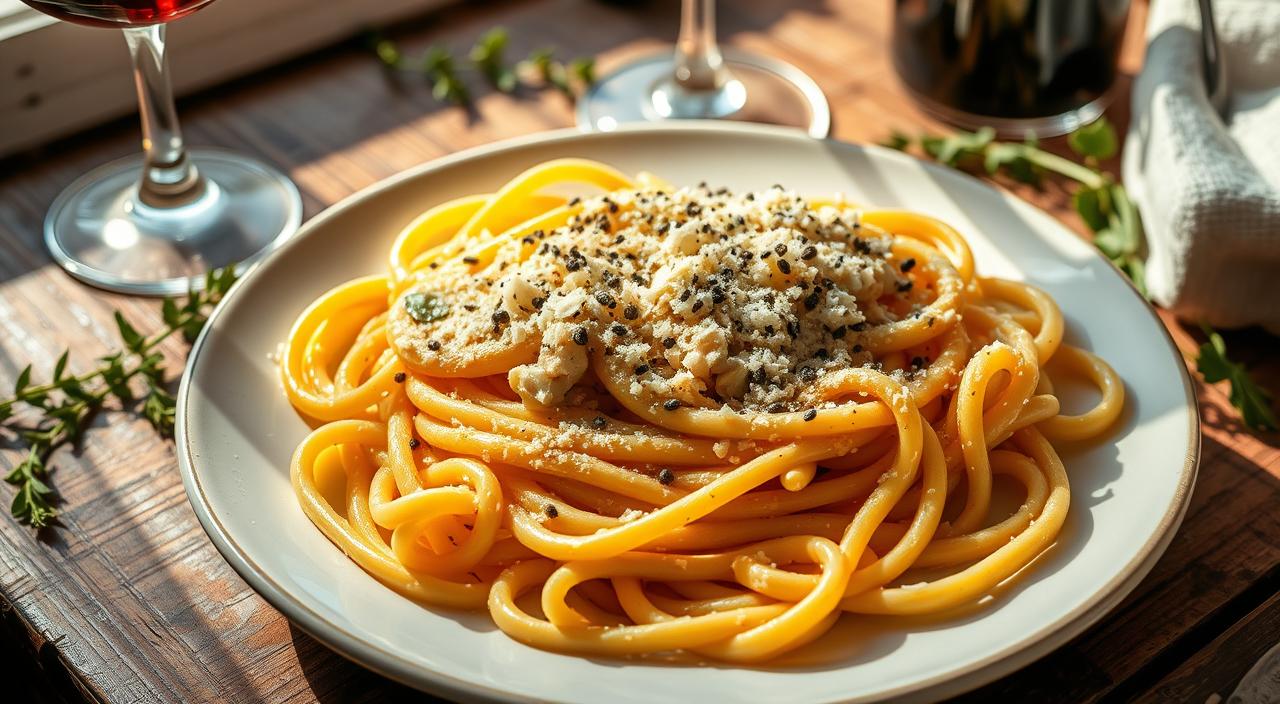Experience the bliss of Cacio e Pepe, an Italian creamy pasta recipe made with just three ingredients. Learn the recipe and bring Italy to your table.
Cacio e Pepe, a simple yet indulgent pasta dish from Rome, has taken the world by storm. With just three core ingredients—pasta, Pecorino Romano cheese, and black pepper—this classic Italian pasta recipe delivers rich, creamy flavors that make every bite a blissful experience. Whether you’re an Italian food enthusiast or a beginner in the kitchen, Cacio e Pepe is a dish that anyone can master.
What is Cacio e Pepe?
Cacio e Pepe, which means “cheese and pepper” in Italian, is a minimalist pasta dish that originated in the Lazio region of central Italy. It’s made with a few key ingredients: Pecorino Romano cheese, black pepper, and pasta. Despite its simplicity, it’s known for its creamy, velvety texture and bold, peppery flavor. The magic of this dish lies in the technique—creating a silky, creamy sauce without the use of cream.
The Origins of Cacio e Pepe
The history of Cacio e Pepe dates back to ancient Rome. It was a dish created by shepherds who needed a quick, hearty meal during their travels. With just a few pantry staples—cheese, pepper, and pasta—they could prepare a satisfying meal on the go. The combination of the sharp, salty Pecorino Romano cheese and the bold kick of black pepper made it the perfect energy-boosting dish.
Today, Cacio e Pepe is a staple of Roman cuisine and has become a beloved comfort food worldwide. While many versions of this dish exist, the Roman version remains the most authentic.
Key Ingredients for Cacio e Pepe
1. Pasta: The Foundation of Cacio e Pepe
The pasta you choose is important, but it doesn’t need to be fancy. Traditional recipes call for tonnarelli or bucatini, both of which are slightly thicker pastas that hold the sauce well. However, you can use spaghetti or any other long pasta you prefer. The key is that the pasta should have a surface that can trap the creamy sauce.
2. Pecorino Romano Cheese: The Star of the Dish
The heart and soul of Cacio e Pepe is Pecorino Romano cheese. This salty, tangy cheese is made from sheep’s milk and has a distinctive, sharp flavor that pairs perfectly with black pepper. When freshly grated, Pecorino Romano adds the right texture and flavor to create the creamy sauce.
For the best results, use freshly grated cheese rather than pre-grated varieties, as this will help achieve the desired creamy texture.
3. Black Pepper: The Perfect Kick
The pepper is the second essential ingredient in Cacio e Pepe. Freshly cracked black pepper adds a spicy, aromatic bite that contrasts beautifully with the creaminess of the cheese. In authentic recipes, the black pepper is toasted in a pan to release its oils and enhance the flavor before being mixed with the pasta.
4. Pasta Water: The Secret Ingredient
Pasta water is the unsung hero in many Italian pasta dishes, including Cacio e Pepe. The starchy water helps to create a smooth, silky sauce that clings to the pasta. This is what makes the sauce so creamy without the use of cream.
How to Make Cacio e Pepe: Step-by-Step Guide
Making Cacio e Pepe may seem like an easy task, but it requires precision and attention to detail. The key is in timing and technique, as you want to ensure the cheese melts smoothly and the pasta is perfectly coated in the creamy sauce.
Step 1: Prepare the Pasta
Start by bringing a large pot of salted water to a boil. Add the pasta and cook it according to the package instructions until it is al dente—firm to the bite but fully cooked. The cooking time may vary depending on the pasta type you choose, but remember to reserve about 2 cups of pasta water before draining.
Step 2: Toast the Pepper
While the pasta is cooking, toast the freshly cracked black pepper in a dry skillet over medium heat. Stir the pepper constantly to avoid burning it. Toasting the pepper will bring out its oils and intensify its flavor. This step is crucial for enhancing the peppery kick in the dish.
Step 3: Combine the Pasta with Pepper
Once the pepper is toasted, add a small amount of the reserved pasta water to the skillet with the pepper, creating a pepper-infused liquid. Add the cooked pasta to the skillet and toss it gently, making sure the pepper coats every strand of pasta.
Step 4: Create the Cheese Sauce
Now comes the most critical step: adding the Pecorino Romano cheese. Slowly add the freshly grated cheese to the pasta while tossing or stirring quickly. The heat from the pasta and the pasta water will help melt the cheese, creating a smooth, creamy sauce that coats the pasta. If the sauce feels too thick, add a bit more pasta water until you reach the desired creamy consistency.
Step 5: Serve and Enjoy this creamy pasta recipe
Once the pasta is well coated with the creamy cheese sauce, it’s time to serve. Plate the Cacio e Pepe, garnish with a little extra freshly cracked black pepper, and enjoy this simple yet satisfying dish!
Tips for Perfect Cacio e Pepe pasta recipe
While Cacio e Pepe is a straightforward dish, there are some tips and tricks to make sure it turns out perfectly every time.
Use Freshly Grated Cheese
Freshly grated Pecorino Romano cheese is a must. Pre-grated cheese doesn’t melt as smoothly and will result in a grainy texture in the sauce.
Don’t Overcook the Pasta
Overcooking the pasta can cause it to become too soft and lose its bite, which will affect the texture of the final dish. Always cook the pasta al dente, which ensures that it retains its shape and texture.
Control the Heat
When adding the cheese to the pasta, make sure the heat isn’t too high, as it can cause the cheese to seize up and become clumpy. If necessary, lower the heat and add a little more pasta water to keep the sauce smooth.
Keep Some Pasta Water
The starchy pasta water is the key to achieving a silky, creamy sauce. Don’t forget to reserve some before draining the pasta. You’ll likely need to use more pasta water than you think, so don’t be shy when adding it to the pan.
Serve Immediately
Cacio e Pepe is best served immediately while it’s still hot and creamy. The sauce can thicken as it cools, so it’s important to enjoy this dish fresh from the pan.
Variations of Cacio e Pepe pasta recipe
While the traditional Cacio e Pepe is beloved for its simplicity, there are some creative variations you can try to enhance the dish. Here are a few ideas:
1. Lemon Cacio e Pepe
Add a zesty twist to your Cacio e Pepe by incorporating a squeeze of fresh lemon juice. The acidity will brighten the dish and balance the richness of the cheese.
2. Cacio e Pepe with Truffle
For a luxurious touch, consider adding truffle oil or truffle salt to your Cacio e Pepe. The earthy flavor of truffles pairs wonderfully with the creamy cheese and pepper.
3. Spicy Cacio e Pepe
If you love spice, add red pepper flakes to the pepper toast. This will give the dish an extra kick and make it even more exciting.
4. Cacio e Pepe with Vegetables
For a more substantial meal, try adding sautéed spinach, broccoli, or zucchini to your Cacio e Pepe. The vegetables add color and nutrition, making the dish more well-rounded.
The Best Wine Pairings for Cacio e Pepe pasta recipe
Cacio e Pepe is rich and creamy, so pairing it with the right wine is essential. Here are some wines that pair well with this flavorful dish:
1. White Wine
A crisp, dry white wine like a Pinot Grigio or Chardonnay works well with the creaminess of the sauce. The acidity of the wine helps balance the richness of the cheese.
2. Red Wine
If you prefer red wine, go for a light Chianti or a Pinot Noir. These wines have enough acidity to complement the dish without overpowering it.
3. Prosecco
For a fun, celebratory pairing, consider a glass of Prosecco. The effervescence of the sparkling wine contrasts nicely with the creamy texture of the Cacio e Pepe.
Final Thoughts: The Bliss of Cacio e Pepe
Cacio e Pepe is a perfect example of the elegance of Italian cuisine. With just a few ingredients, this dish creates a rich, bold flavor that captivates the palate. The smooth, creamy texture, paired with the sharpness of Pecorino Romano and the heat of black pepper, makes every bite a delight.
Whether you’re preparing it for a cozy evening or a special celebration, Cacio e Pepe transports you straight to Rome. Simply gather your ingredients, follow the steps, and savor the deliciousness of this classic Italian dish. It’s the ultimate creamy pasta that any Italian food lover will cherish!

